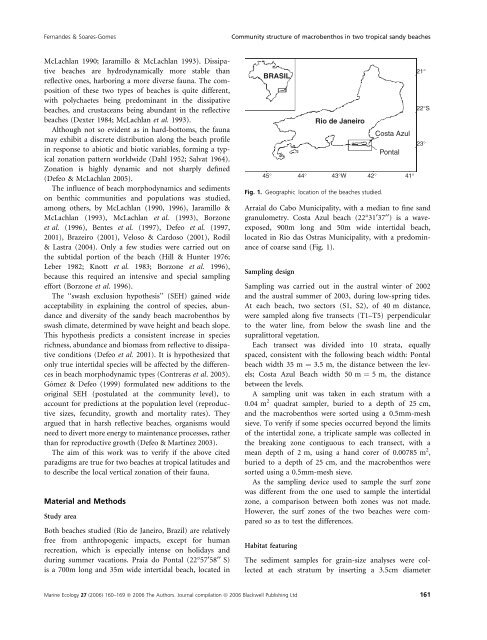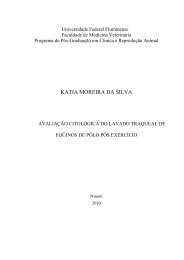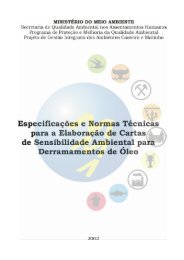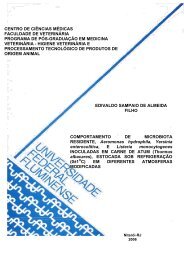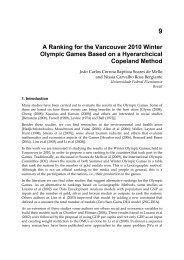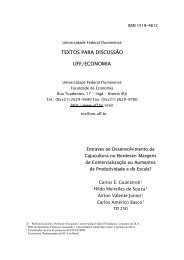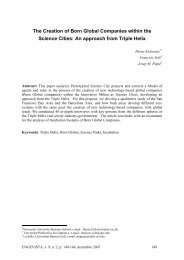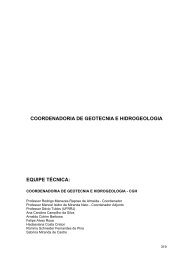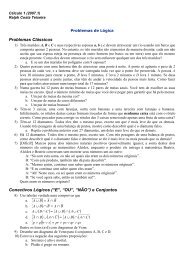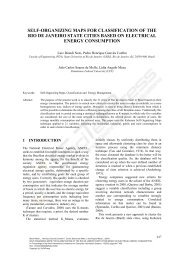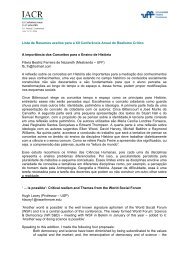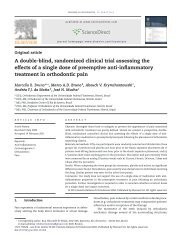Community structure of macrobenthos in two tropical sandy ... - UFF
Community structure of macrobenthos in two tropical sandy ... - UFF
Community structure of macrobenthos in two tropical sandy ... - UFF
Create successful ePaper yourself
Turn your PDF publications into a flip-book with our unique Google optimized e-Paper software.
Fernandes & Soares-Gomes<br />
<strong>Community</strong> <strong>structure</strong> <strong>of</strong> <strong>macrobenthos</strong> <strong>in</strong> <strong>two</strong> <strong>tropical</strong> <strong>sandy</strong> beaches<br />
McLachlan 1990; Jaramillo & McLachlan 1993). Dissipative<br />
beaches are hydrodynamically more stable than<br />
reflective ones, harbor<strong>in</strong>g a more diverse fauna. The composition<br />
<strong>of</strong> these <strong>two</strong> types <strong>of</strong> beaches is quite different,<br />
with polychaetes be<strong>in</strong>g predom<strong>in</strong>ant <strong>in</strong> the dissipative<br />
beaches, and crustaceans be<strong>in</strong>g abundant <strong>in</strong> the reflective<br />
beaches (Dexter 1984; McLachlan et al. 1993).<br />
Although not so evident as <strong>in</strong> hard-bottoms, the fauna<br />
may exhibit a discrete distribution along the beach pr<strong>of</strong>ile<br />
<strong>in</strong> response to abiotic and biotic variables, form<strong>in</strong>g a typical<br />
zonation pattern worldwide (Dahl 1952; Salvat 1964).<br />
Zonation is highly dynamic and not sharply def<strong>in</strong>ed<br />
(Defeo & McLachlan 2005).<br />
The <strong>in</strong>fluence <strong>of</strong> beach morphodynamics and sediments<br />
on benthic communities and populations was studied,<br />
among others, by McLachlan (1990, 1996), Jaramillo &<br />
McLachlan (1993), McLachlan et al. (1993), Borzone<br />
et al. (1996), Bentes et al. (1997), Defeo et al. (1997,<br />
2001), Brazeiro (2001), Veloso & Cardoso (2001), Rodil<br />
& Lastra (2004). Only a few studies were carried out on<br />
the subtidal portion <strong>of</strong> the beach (Hill & Hunter 1976;<br />
Leber 1982; Knott et al. 1983; Borzone et al. 1996),<br />
because this required an <strong>in</strong>tensive and special sampl<strong>in</strong>g<br />
effort (Borzone et al. 1996).<br />
The ‘‘swash exclusion hypothesis’’ (SEH) ga<strong>in</strong>ed wide<br />
acceptability <strong>in</strong> expla<strong>in</strong><strong>in</strong>g the control <strong>of</strong> species, abundance<br />
and diversity <strong>of</strong> the <strong>sandy</strong> beach <strong>macrobenthos</strong> by<br />
swash climate, determ<strong>in</strong>ed by wave height and beach slope.<br />
This hypothesis predicts a consistent <strong>in</strong>crease <strong>in</strong> species<br />
richness, abundance and biomass from reflective to dissipative<br />
conditions (Defeo et al. 2001). It is hypothesized that<br />
only true <strong>in</strong>tertidal species will be affected by the differences<br />
<strong>in</strong> beach morphodynamic types (Contreras et al. 2003).<br />
Gómez & Defeo (1999) formulated new additions to the<br />
orig<strong>in</strong>al SEH (postulated at the community level), to<br />
account for predictions at the population level (reproductive<br />
sizes, fecundity, growth and mortality rates). They<br />
argued that <strong>in</strong> harsh reflective beaches, organisms would<br />
need to divert more energy to ma<strong>in</strong>tenance processes, rather<br />
than for reproductive growth (Defeo & Martínez 2003).<br />
The aim <strong>of</strong> this work was to verify if the above cited<br />
paradigms are true for <strong>two</strong> beaches at <strong>tropical</strong> latitudes and<br />
to describe the local vertical zonation <strong>of</strong> their fauna.<br />
Material and Methods<br />
Study area<br />
Both beaches studied (Rio de Janeiro, Brazil) are relatively<br />
free from anthropogenic impacts, except for human<br />
recreation, which is especially <strong>in</strong>tense on holidays and<br />
dur<strong>in</strong>g summer vacations. Praia do Pontal (22°57¢58¢¢ S)<br />
is a 700m long and 35m wide <strong>in</strong>tertidal beach, located <strong>in</strong><br />
BRASIL<br />
Arraial do Cabo Municipality, with a median to f<strong>in</strong>e sand<br />
granulometry. Costa Azul beach (22°31¢37¢¢) is a waveexposed,<br />
900m long and 50m wide <strong>in</strong>tertidal beach,<br />
located <strong>in</strong> Rio das Ostras Municipality, with a predom<strong>in</strong>ance<br />
<strong>of</strong> coarse sand (Fig. 1).<br />
Sampl<strong>in</strong>g design<br />
Sampl<strong>in</strong>g was carried out <strong>in</strong> the austral w<strong>in</strong>ter <strong>of</strong> 2002<br />
and the austral summer <strong>of</strong> 2003, dur<strong>in</strong>g low-spr<strong>in</strong>g tides.<br />
At each beach, <strong>two</strong> sectors (S1, S2), <strong>of</strong> 40 m distance,<br />
were sampled along five transects (T1–T5) perpendicular<br />
to the water l<strong>in</strong>e, from below the swash l<strong>in</strong>e and the<br />
supralittoral vegetation.<br />
Each transect was divided <strong>in</strong>to 10 strata, equally<br />
spaced, consistent with the follow<strong>in</strong>g beach width: Pontal<br />
beach width 35 m ¼ 3.5 m, the distance between the levels;<br />
Costa Azul Beach width 50 m ¼ 5 m, the distance<br />
between the levels.<br />
A sampl<strong>in</strong>g unit was taken <strong>in</strong> each stratum with a<br />
0.04 m 2 quadrat sampler, buried to a depth <strong>of</strong> 25 cm,<br />
and the <strong>macrobenthos</strong> were sorted us<strong>in</strong>g a 0.5mm-mesh<br />
sieve. To verify if some species occurred beyond the limits<br />
<strong>of</strong> the <strong>in</strong>tertidal zone, a triplicate sample was collected <strong>in</strong><br />
the break<strong>in</strong>g zone contiguous to each transect, with a<br />
mean depth <strong>of</strong> 2 m, us<strong>in</strong>g a hand corer <strong>of</strong> 0.00785 m 2 ,<br />
buried to a depth <strong>of</strong> 25 cm, and the <strong>macrobenthos</strong> were<br />
sorted us<strong>in</strong>g a 0.5mm-mesh sieve.<br />
As the sampl<strong>in</strong>g device used to sample the surf zone<br />
was different from the one used to sample the <strong>in</strong>tertidal<br />
zone, a comparison between both zones was not made.<br />
However, the surf zones <strong>of</strong> the <strong>two</strong> beaches were compared<br />
so as to test the differences.<br />
Habitat featur<strong>in</strong>g<br />
Rio de Janeiro<br />
45° 44° 43°W 42° 41°<br />
Fig. 1. Geographic location <strong>of</strong> the beaches studied.<br />
Costa Azul<br />
Pontal<br />
22°S<br />
The sediment samples for gra<strong>in</strong>-size analyses were collected<br />
at each stratum by <strong>in</strong>sert<strong>in</strong>g a 3.5cm diameter<br />
21°<br />
23°<br />
Mar<strong>in</strong>e Ecology 27 (2006) 160–169 ª 2006 The Authors. Journal compilation ª 2006 Blackwell Publish<strong>in</strong>g Ltd 161


